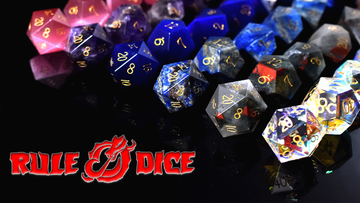In Dungeons & Dragons (DND), dice serve as much more than just random number generators; they’re essential tools that shape characters, drive the storyline, and determine the outcomes of combat. Whether you’re making a skill check or deciding the fate of a battle, players rely on various dice types (d20, d12, d10, etc.) to enact the game’s core mechanics. This article delves into the different ways dice are used in DND, helping players understand how to make the most of them to enhance their gaming experience, with references to guidelines found in the Player’s Handbook.
1. The Main Dice Types and Their Uses
The main dice used in DND include the d4, d6, d8, d10, d12, and d20, each serving a specific purpose in gameplay:
- d20: This is the most frequently used die in DND, utilized for “ability checks,” “attack rolls,” and “saving throws.” Whenever a character attempts an action—like hitting an enemy or dodging a trap—they typically roll a d20 to determine success.
- d6, d8, d10, d12: These dice are commonly used for determining damage dealt by weapons or spells. For instance, a longsword might deal 1d8 damage, while certain spells can deliver higher damage using a d12.
- d4: Often used for smaller damage rolls or lesser effects, the d4 comes into play with light weapons or certain spells.
Reference: The Player’s Handbook states, “When making an ability check, an attack roll, or a saving throw, you usually roll a d20 and add a modifier” (Player's Handbook, p. 7).
2. Ability Checks: Combining Skills and Dice Rolls
Ability checks are one of the most common dice actions in DND, determining whether a character successfully completes a task, like picking a lock, identifying a poison, or persuading an NPC. Players roll a d20 and add any relevant ability and skill modifiers.
Difficulty Class (DC) is a number set by the Dungeon Master (DM), typically ranging from 5 to 30. If the d20 roll plus modifiers meets or exceeds the DC, the character succeeds. For example, a character might make a “Strength check” when attempting to jump across a chasm; the DM will set a DC for the check, and the player will roll a d20 and add their Strength modifier to see if they succeed.
Reference: According to the Player’s Handbook, “When you make an ability check, you roll a d20 and add the appropriate modifier” (Player’s Handbook, p. 174).
3. Attack and Damage Rolls: Deciding Combat Outcomes
Dice rolls are also crucial in combat to determine whether an attack hits and how much damage it deals. Players generally roll a d20 to check if their attack lands and then use other dice (such as d6 or d8) to calculate damage if it does.
- Attack Rolls: Players roll a d20 and add their attack modifier. If the total equals or exceeds the target’s Armor Class (AC), the attack hits.
- Damage Rolls: Once an attack hits, the player rolls a damage die (like a d8 for a longsword) and adds any damage modifiers to determine how much damage the target takes.
Reference: “An attack roll determines whether an attack hits the target, while a damage roll determines the amount of damage dealt” (Player’s Handbook, p. 194).
4. Saving Throws: Resisting Effects and Damage
In some situations, characters must roll to avoid or reduce harmful effects. These rolls, known as “saving throws,” help determine if a character resists a spell, avoids a trap, or shrugs off poison.
Each saving throw is linked to an ability score, such as Strength, Dexterity, Constitution, Intelligence, Wisdom, or Charisma. For example, a character might roll a Constitution saving throw to resist the effects of poison or a Dexterity saving throw to dodge a fireball spell.
Reference: The Player’s Handbook states, “A saving throw represents an attempt to resist a spell, a trap, a poison, or a similar threat” (Player’s Handbook, p. 179).
5. Dice-Rolling Strategies: Improving Your Chances of Success
While dice rolling has an element of chance, players can use strategies to improve their odds:
- Optimize Ability Scores: When creating a character, focus on high scores in abilities that are relevant to your class. For instance, a fighter benefits from high Strength and Constitution scores.
- Use Advantage and Disadvantage: Sometimes, the DM grants “advantage” (roll two d20s and take the higher result) or “disadvantage” (roll two d20s and take the lower result) based on circumstances, which can significantly impact the outcome.
- Enhance Skill Bonuses: Players can increase their skill bonuses by leveling up, using certain items, or choosing particular class abilities, making them more likely to succeed on related rolls.
Reference: “The advantage and disadvantage mechanic allows players to roll twice and choose the higher or lower result, depending on the situation” (Player’s Handbook, p. 173).
Conclusion
Dice in DND are far more than simple chance devices—they’re extensions of character abilities, integral to shaping the story and crafting strategic gameplay. Understanding the purpose of each type of roll, from ability checks and attack rolls to saving throws, can make a huge difference in how you play and enjoy the game. Mastering these dice mechanics and strategies ensures that each adventure, encounter, and interaction is uniquely exciting and dynamic.

